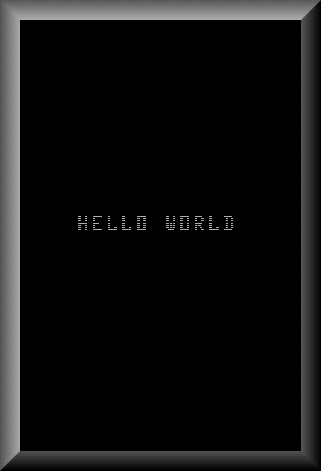
HELLO WORLD (1)
Well, the usual first, most simple program!
Vectrex is capable of displaying simple texts on its screen. The easiest way to display a simple message is to use the ROM routines. For this example we will only use three BIOS functions.
The text display function we will use is called Print_Str_d ($F37A). It requires the direct page register to be set to $d0. It also requires 3 parameters:
U-reg points to string list
A-reg = relative Y position
B-reg = relative X position
The second used BIOS function is responsible for a clean display. It is called Wait_Recal ($F192). This function should be called every 'display round'. It waits for a certain period of time, recalibrates the vector hardware, sets the pen to zero position and so on. It also sets DP to D0, so we don't have to do it. The BIOS default time to wait is 30000 cycles, which will display our vectors 50 times per second (if we have enough time).
So he above function destroys some inner settings, as well as cleaning some others. The 'Wait_Recal' call is necessary for example to set the intensity after each round. This is not immediately obvious, since the program runs well on any vectrex - for a minute or so. But slowly the intensity information will 'drift' towards zero. After 1 or 2 minutes you won't see our 'HELLO WORLD' any more if we do not set the intensity. There are BIOS functions for this. For the easiness of the example we pick a fixed intensity function, Intensity_5F ($F2A5). This function (quite obviously) sets the intensity to $5f, which is fairly bright, but not maximum ($7f).
We don't have to worry about uninitialized BIOS stuff, because there is no such thing. When vectrex boots up it first initializes itself and its BIOS, so some default values are always present, like the above timer or a default text size. In this first example we do not change any of the default settings.
Here a screenshot:

Here is a source code to a most simple 'HELLO WORLD':
OK, let's start at the top of the source. First thing we do is to set some defines, so the source looks a bit more intuitive. You will probably know such things. Every modern compiler/assembler will allow defining of constants. In the next examples this section will be replaces by an 'include' directive, which (as you might have guessed) includes all possible global definitions. In this example we tell the assembler what ROM addresses our function names represent (sorry about being to obvious).
Vectrex 'programs' (roms) always start at location 0. The first thing we need is a copyright information of GCE, "g GCE". This string MUST be present in order for your program to work, the BIOS checks for it. If the above string is not found it will boot with minestorm instead! The string can be followed by any string you like.
NOTE: only capital letters are supported, small letters represent special characters (like the copyright sign) (see appendix E). Strings must always be terminates with a $80. Following that $80 is a word pointer to a music structure. I won't go into music structures at this point. For now it is enough to know that in the vectrex BIOS ROM 13 pieces of music are integrated. Music1 is the power-on music, Crazy Coaster and Narrow Escape. Following is a 4 byte structure describing the format of the following text. First value is the height of the text. This is -8, since the text goes from top to bottom, than the width (positive, from left to right). Followed by the (not relative) coordinates Y, X. Than the string itself follows, terminated by a $80. It would be possible to include some other structures like this one (height, width, Y, X, "STRING", $80). The game header finishes of with a 0.
The byte following after the 0 is the first byte of code. Since we don't want to initialize anything we go right into our display loop from the start. The following steps are repeated eternally.
* At first we do call the BIOS function Wait_Recal, calling this function at the beginning of every display round insures a stable image (amongst other things). Since the function does not expect any values and does not return anything, a call is at this point enough.
* We than have to make sure our intensity stays the same even after a Wait_Recal call. We call the function Intensity_5F ($F2A5), which does exactly that. It sets the vector intensity (brightness) to $5f.
* Next thing we do is prepare the call of the text display function Print_Str_d. We load the U register with the address of the to be displayed text. Since we just called Wait_Recal our position on the vectrex screen should currently be known and 0, 0. We load the relative Y coordinate to A. We load the relative X coordinate to B. Since we just called Wait_Recal we also know that DP is pointing to D0, which is required by Print_Str_d. Thus we have prepared all there is for Print_Str_d.
* Now let us call Print_Str_d. The text is displayed on the screen. We are done with drawing the screen. Since that is all we want our program to do we are finished at this point. The only thing left to do is to make sure that the screen gets repainted constantly, so we
* jump back to the top, and do everything again. At the end of the source is our "HELLO WORLD" string (again terminated by a $80).
Done! This is your first running vectrex program! Wasn't hard was it?